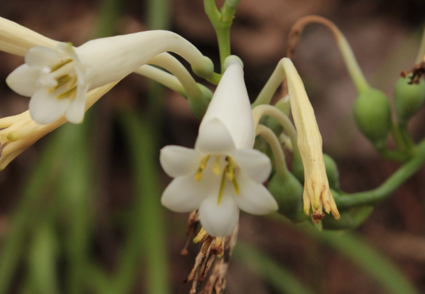Abstract
Botanical explorations in Sierra Madre Occidental, Mexico resulted in the location of new populations of Polianthes montana in the south of Durango state. This species is little known and there are conflicts on its identification and geographic distribution range, for these reasons here are provided discussions and an extended morphological description. Also, additional individuals from a Polianthes population were collected almost on the border of the states of Durango and Sinaloa, and after a rigorous analysis of the specimens, it was concluded that they do not belong to any of the known taxa in the genus and it is proposed here as a new species that morphologically resembles P. alboaustralis and P. montana but differs from the former in having (1–)3–4 ensiform leaves (vs. 2–6 linear), raceme inflorescence (vs. spike), perigone without a nectary (vs. nectary present in the floral tube), and filaments 6.5–9.7 mm long (vs. 2–10 mm long). From P. montana, it differs in the perigone size (5–5.5 × 0.4–0.7 cm vs. 2–2.8 × 0.3–0.5 cm), the orientation and size of perigone lobes (diffuse to divergent, 5.6–6.8 × 3.4–5 mm vs. adpressed to assurgent, 2.4–3 mm × 1.9–2.3 mm), longer filaments (6.5–9.7 mm vs. 5–5.4 cm), and styles (4.2–4.8 cm vs. 1.7–2 cm). Photographs, notes on phenology, geographic distribution, conservation status, and habitat are included, along with a map and an identification key to Polianthes subgenus Polianthes.
References
<p>Barba-Gonzalez, R., Rodríguez-Domínguez, J.M., Castañeda-Saucedo, M.C., Rodríguez, A., Van Tuyl, J.M. & Tapia-Campos, E. (2012) Mexican geophytes I. The genus <em>Polianthes</em>. <em>Floriculture and Ornamental Biotechnology </em>1: 122–128.</p>
<p>Castro-Castro, A., González-Gallegos, J.G. & Rodríguez, A. (2015) A new species of <em>Polianthes</em> subgenus <em>Bravoa</em> (Asparagaceae, Agavoideae) from Jalisco, Mexico. <em>Phytotaxa</em> 201 (2): 140–148. https://doi.org/10.11646/phytotaxa.201.2.4</p>
<p>Castro-Castro, A., Flores-Argüelles, A., Hernández-López, L. & Rodríguez, A. (2016) <em>Polianthes quilae </em>(Poliantheae, Agavaceae), a new and endemic species to western Mexico. <em>Systematic Botany </em>41: 720–726. https://doi.org/10.1600/036364416X692316</p>
<p>González-Elizondo M.S., González-Elizondo, M., Tena-Flores, J., González-Elizondo, M.S., Ruacho-González, L., López-Enríquez, I.L., Retana-Rentería, F.I. & Tena-Flores, J.A. (2012a) Ecosystems and diversity of the Sierra Madre Occidental. <em>In:</em> Gottfried, G.J., Ffolliott, P.F., Gebow, B.S., Eskew, L.G. & Collins, L.C. (Eds.) <em>Merging science and management in a rapidly changing world: Biodiversity and management of the Madrean Archipelago III</em>. U.S. Department of Agriculture, Forest Service, Rocky Mountain Research Station. Fort Collins, pp. 204−211.</p>
<p>González-Elizondo, M.S., González-Elizondo, M., Tena-Flores, J.A., Ruacho-González, L. & López-Enríquez, I.L. (2012b) Vegetación de la Sierra Madre Occidental, México: una síntesis. <em>Acta Botanica Mexicana</em> 100: 351–403. https://doi.org/10.21829/abm100.2012.40</p>
<p>Gries, C., Gilbert, E.E. & Franz, N.M. (2014) Symbiota - A virtual platform for creating voucher-based biodiversity information communities. <em>Biodiversity Data Journal</em> 2: e1114. https://doi.org/10.3897/BDJ.2.e1114</p>
<p>IUCN (2022) Guidelines for using the IUCN Red List Categories and Criteria. Version 15.1. Standards and Petitions Committee. Available from: https://www.iucnredlist.org/resources/redlistguidelines (accessed 1 October 2022)</p>
<p>La Llave, P. & Lexarza, J. (1824) <em>Novorum vegetabilium descriptiones</em> <em>I. </em>M. Rivera, Mexico, 32 pp.</p>
<p>Linnaeus, C. (1753) <em>Species plantarum</em>. Salvius, Stockholm, 1200 pp.</p>
<p>Morrone, J.J., Escalante, T. & Rodríguez-Tapia, G. (2017) Mexican biogeographic provinces: Map and shapefiles. <em>Zootaxa</em> 4277 (2): 277–279. https://doi.org/10.11646/zootaxa.4277.2.8</p>
<p>Pío-León, J.F., González-Elizondo, M., Vega-Aviña, R., González-Elizondo, M.S., González-Gallegos, J.G., Salomón-Montijo, B., Millán-Otero, M.G. & Lim-Vega, C.A. (2022) Las plantas vasculares endémicas del estado de Sinaloa, México. <em>Botanical Sciences</em> 100: Online first. https://doi.org/10.17129/botsci.3076</p>
<p>QGIS.org (2022) QGIS Geographic Information System Version 3.28. QGIS Association. [http://www.qgis.org]</p>
<p>Roemer, M.J. (1847) <em>Familiarum naturalium regni vegetabilis synopses monographicae</em>, <em>IV. Ensatae</em>. Landes-Industrie-Comptor, Weimar, 314 pp.</p>
<p>Rose, J.N. (1903) Studies on Mexican and Central American plants. <em>Contributions from the United States National Herbarium </em>8: 1–56.</p>
<p>Serrano-Casas, H., Solano, E. & Terrazas, T. (2011) Anatomía floral comparativa del género <em>Polianthes</em> (Agavaceae). <em>Revista Mexicana de Biodiversidad </em>82: 145–152. https://doi.org/10.22201/ib.20078706e.2011.1.368</p>
<p>Servicio Geológico Mexicano (2021) Panorama minero del estado de Sinaloa. Servicio Geológico Mexicano, Pachuca, 45 pp.</p>
<p>Simpson, M.G. (2006) <em>Plant systematics</em>. Elsevier Academic Press, Massachusetts, 590 pp.</p>
<p>Solano, C.E. (2000) <em>Sistemática del género Polianthes</em> <em>L. (Agavaceae). </em>Tesis de doctorado. Facultad de Ciencias, Universidad Nacional Autónoma de México. México, D.F., 291 pp.</p>
<p>Solano, C.E. & Dávila Aranda, P.D. (2003) <em>Polianthes multicolor </em>(Agavaceae), especie nueva de Guanajuato, México. <em>Novon </em>13: 119–122. https://doi.org/10.2307/3393576</p>
<p>Solano, C.E. & Feria, T.P. (2007) Ecological niche modeling and geographic distribution of the genus <em>Polianthes</em> L. (Agavaceae) in Mexico: using niche modeling to improve assessments of risk status. <em>Biodiversity and Conservation</em> 16: 1885–1900. https://doi.org/10.1007/s10531-006-9091-0</p>
<p>Solano, C.E. & Ríos-Gómez, R. (2014) <em>Polianthes alboaustralis</em> (Asparagaceae, Agavoideae), a new species from the State of Oaxaca, Mexico. <em>Phytotaxa </em>174 (2): 97–104. https://doi.org/10.11646/phytotaxa.174.2.4</p>
<p>Solano, C.E., García-Mendoza, A. & Ríos-Gómez, R. (2018) <em>Polianthes venustuliflora</em> (Asparagaceae, Agavoideae), una especie nueva endémica de Michoacán, México. <em>Acta Botanica Mexicana </em>126: e1441. https://doi.org/10.21829/abm126.2019.1441</p>
<p>Vega, A.R., Vega, L.I.F. & Delgado, V.F. (2021) <em>Flora nativa y naturalizada de Sinaloa</em>. Universidad Autónoma de Sinaloa & Colegio de Posgraduados, Guadalajara, 243 pp.</p>
<p>Villaseñor, J.L. (2016) Checklist of the native vascular plants of Mexico. <em>Revista Mexicana de Biodiversidad </em>87: 559–902.</p>
<p> https://doi.org/10.1016/j.rmb.2016.06.017</p>


